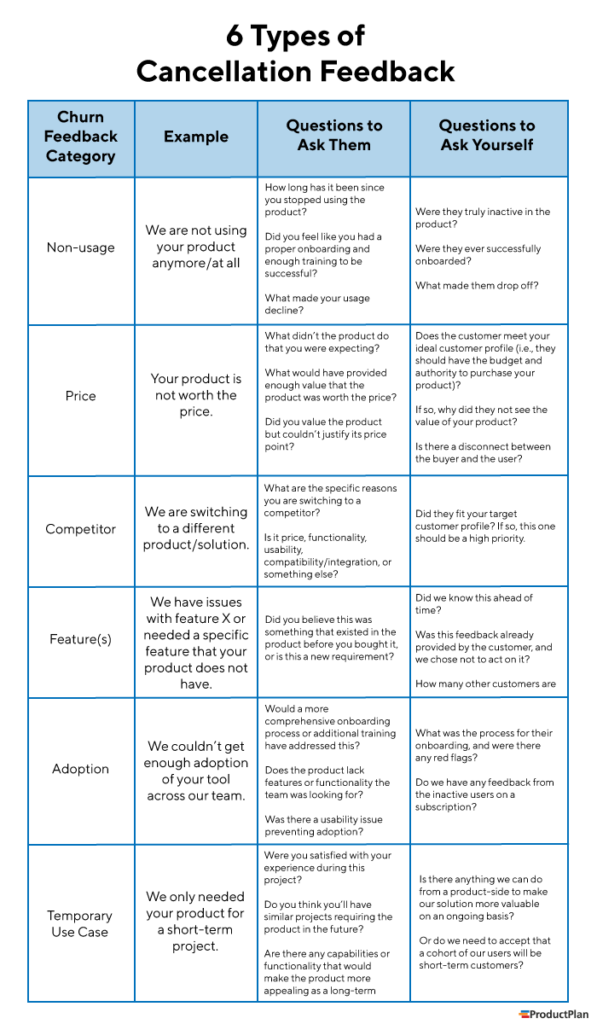At ProductPlan, we’re pretty obsessed with user feedback. We gather as much feedback as possible, intending to learn more about our diverse user base to create a better product.
While hearing from happy customers is good for our egos, the less contented a customer is, the more valuable their feedback may be. Less-than-awesome experience is far more likely to shine a light on shortcomings in the product, customer support, or onboarding.
But the most rewarding—yet scary—sources of feedback come from customers who have already headed for the hills. Why are observations and criticisms so important?
The “exit interviews” from churned customers yield unvarnished truths that current customers are too polite or afraid to offer up. These former customers have nothing to lose by unabashedly bashing the product in churn feedback, pointing out flaws, and lamenting the “if only” aspects of our solutions.
How ProductPlan Collects Churn Feedback
You might be wondering how to efficiently manage feedback from people so unsatisfied with their experience that they’ve canceled their subscription or completed a trial without making a purchase. Do you need to block the exits until they’ve aired their grievances?
At ProductPlan, we typically gather churn feedback from one of two channels:
- When someone cancels their subscription in the app, we automatically provide an opportunity to provide input during that process.
- When someone contacts our customer support team to cancel, the staff is trained to ask simple, polite questions to see if they have any feedback. Typically along the lines of, “We’re sorry to see you go! Would you mind telling me a bit about why you decided to cancel? Any feedback is really helpful for our team’s understanding.”
Other ways to collect feedback
These aren’t the only ways to get it. Some companies will send a survey after the cancellation is completed or even make a polite phone inquiry to ask them why they’ve decided to stop using the product. In general, the more automated and programmatic your feedback solicitation is, the larger the sample size you’ll get. The larger sample size makes it more consistent and representative of departing customers.
But regardless of how you ask, remember that now is not the time to try and change their mind or convince them that they should have stayed. There are plenty of opportunities to try and win back former customers at a later date. You can entice them with promotions, incentives, or newly-introduced features and functionality. But, while things are still fresh, it’s better to focus on learning what made them leave in the first place.
At ProductPlan, the collection comes from user-submitted feedback when canceling in the app (automatic) and from manually requested feedback. Manually requested feedback is when someone reaches out to support to cancel and they ask to see if the customer has any feedback.
Our customer success team collects and shares all cancellation feedback every month. It’s essential to review feedback periodically as it may unveil trends that can be mapped back to changes in the product or even seasonality.
The Six Types of Cancellation Feedback
We have found that most feedback falls into six categories. Grouping this type of feedback is handy for two reasons. First, you can chart out why people are quitting your product instead of treating each case as an individual anecdote.
If 65% of customers are leaving because of price, you might be selling at the wrong price point, while droves of customers switching to a particular competitor might mean they’ve got some functionality you need to catch up on.
Second, each type of response begets particular follow-up questions. This way, when you have the opportunity to delve a little deeper, it’s helpful to have your line of questioning already mapped out.
This table illustrates the six categories we use to classify feedback as well as what additional questions you can ask in each case to learn a little more from them and to spark an internal discussion about why things didn’t work out.

Build a Strategy to Handle Churn Feedback from Canceled Customers
To make this a part of your customer lifecycle routine, you’ll need to do a little upfront work.
Make it a habit
You must make sure to collect this feedback. Are you asking the questions (and aggregating answers) consistently?
If not, they should be part of the customer service script, added to the product or included in the automated flow of emails.
Follow-up protocols
Create a table similar to the one above but customized for your product. Don’t let departing customers off too easy. Try to wring a bit of insight out of them before they’re entirely out the door.
Even if they’re a lost cause, they can help you do better in the future or hone your ideal personas, targeting, and messaging.
Spotting opportunities
Customer churn feedback can reveal some former customers that could be ripe for a win-back. If they didn’t see the value proposition (but the value is there), it might be the offer of some free training for a professional services engagement. If the price was the culprit, maybe it’s a special offer or suggesting a lower-priced product tier.
Forward these along to sales and marketing. They can work their magic and try to save customers that were on the fence before calling it quits.
Eliminate objections
Each canceling customer is giving you (at least) one reason why the product didn’t work for them. Look to your product roadmap and see how many of those reasons you can eliminate by improving the product, the sales process, or onboarding.
No product is going to be perfect for everyone. But the more causes of rejection you can eradicate, the higher your success rate will be.
Fight Churn with Churn (data)
We’re not usually happy when a customer says goodbye. However, a good product management team will strive to turn those negatives into positives by learning from each experience. By being afraid to ask former customers why they’re canceling, you’re missing out on the chance to learn from failures. It’s nothing personal, and a customer who tried, bought and bailed still has much value to offer.
The more you learn about why people are leaving, the better you can combat other customers joining them. With churn feedback in hand, you can improve the product and spot future flight risks based on their usage behavior.
Want to learn how to prioritize customer churn feedback?




